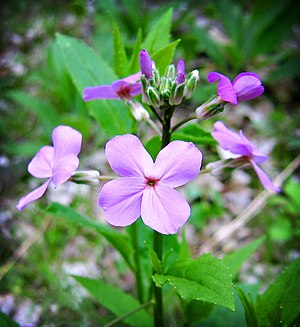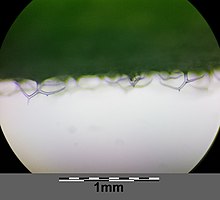Ordinary night vio
| Ordinary night vio | ||||||||||||
|---|---|---|---|---|---|---|---|---|---|---|---|---|

Common night vole ( hesperis matronalis ) |
||||||||||||
| Systematics | ||||||||||||
|
||||||||||||
| Scientific name | ||||||||||||
| Hesperis matronalis | ||||||||||||
| L. |
The Ordinary Nachtviole ( Hesperis matronalis ), also Common Nachtviole , Red Nachtviole , Matronenblume or Kilts called, is a plant of the genus of Nachtviolen ( Hesperis ) from the family of the cabbage family (Brassicaceae). The part of the name “night” comes from the fact that the flowers smell most intensely in the evening.
description
The common night violet is a biennial or perennial herbaceous plant that reaches heights of between 40 and 100 centimeters. The root is spindle-shaped and often multi-headed. The stem is erect, occasionally simple but mostly branched and almost bald or hirsute. If it is hairy, the hair is mainly stalked two-way. The numerous foliage leaves are basal and ovate to lanceolate, pointed to long pointed and toothed to almost entire margins, simply hairy or almost bald. The leaf stalks get shorter from the base of the plant towards the tip.
The species blooms from April to July in several clusters of flowers without bracts , which reach a diameter of 1.5 to 2.5 cm. The four sepals are elongated purple with a greenish tip, the four petals are 18 to 25 mm long with a narrow, long nail and an obovate plate. The anthers are 3 to 3.5 mm long, the stylus 1 to 4 mm long. The scar has two upright lobes lying next to one another. The flowers smell very strongly, but pleasantly, towards evening and night. The seeds ripen in pods 40 to 100 mm long and 1.5 to 2 mm wide . The valves have median and lateral nerves. The seeds are single row and about 3 mm long.
The species has chromosome number 2n = 14, 24 or 28.
distribution
The species is found in Europe and Central and Southwest Asia . Their natural range extends from south-east Europe (Slovak and Hungarian low mountain ranges, Illyria) to the south-east Alps. It also occurs in the Italian Apennines. It is naturally absent in the lowlands almost everywhere and also in areas in higher low mountain ranges, as well as in low mountain ranges with low-lime rocks. In the southeastern Alps, the distribution area extends to 800 meters above sea level. In the Allgäu Alps, it rises southwest above the Breitgehren-Alp in the Rappenalpental near Einödsbach in Bavaria up to 1220 m above sea level.
In Central Europe, the common night vole has been cultivated in cottage gardens for many centuries. As a result, it has become overgrown and naturalized almost everywhere in Germany and all of Central Europe. In addition, the species was introduced to North America in the 16th century and is also considered a neophyte there .
The common night violet needs nutrient-rich, somewhat moist, loose, stony-sandy and humus-rich loamy soil . The species is mainly found in river and stream valleys in riparian forests and bushes. It thrives above all in companies of the Alno-Ulmion association, but also occurs in those of the Aegopodion or Filipendulion associations. But she also lives in ruderal corridors . The species tolerates shade well.
ecology
The common night violet is a biennial or short-lived perennial stem plant that tastes hot thanks to mustard oils .
The flowers are homogamous to pre-male "plate flowers" with nectar glands on the inside of the stamen base. The nectar is difficult to access. Only in the evening do the flowers smell of violets . The flowers are pollinated by insects , especially moths . Although the inwardly opening dust bag the scar dusting, is regularly cross-pollination , including by hoverflies , bees and butterflies . Flowering time is from April to July.
The fruits are pods that are active as animal and wind spreaders. Their seeds are also spread through running waters. The species spreads as garden refugees .
The species is important as a food plant for caterpillars of various butterflies , such as the aurora butterfly ( Anthocharis cardamines ) and the small cabbage white butterfly ( Pieris rapae ), but also various veil and half-moths , especially Plutella porrectella .
Systematics
Hesperis matronalis was first published in 1753 by Carl von Linné in Species Plantarum .
Together with Hesperis sylvestris, the species becomes the collective species Hesperis matronalis agg. summarized. In addition to the nominotypical taxon Hesperis matronalis subsp. matronalis the other subspecies :
- Hesperis matronalis subsp. cladotricha (Borb.) Hayek ; it occurs on the Balkan Peninsula and in Romania
- Hesperis matronalis subsp. nivea (Baumg.) Kulcz. (Syn .: Hesperis matronalis subsp. Candida (Kit.) Hegi and E. Schmid ); it occurs in Europe from Spain to Romania, but avoids the north and south
- Hesperis matronalis subsp. shurii Soó ; it occurs in the Eastern Carpathians
- Hesperis matronalis subsp. voronovii (N. Busch) PW Ball ; it occurs in Crimea, Turkey and Georgia.
Sometimes a feral form of the cultivated hybrid Hesperis matronalis 'Alba' is found.
Toxicity
The common night violite is poisonous in all parts, but especially the seeds. However, their degree of danger is classified as low. Active ingredients are cardenolide - glycosides and mustard oil glycosides.
However, if used sparingly, some parts of the plant can be consumed.
Culture
The common night violet is cultivated in gardens because of its scent (similar to that of Levkojen ) and is often found in seed mixtures, as the species can be easily reproduced. This has also greatly favored the spread in the USA . Different hybrids were crossed, most notably a white form Hesperis matronalis 'Alba'.
The seeds of the common night vole have a pungent taste similar to that of watercress . Clusius recommends it for coughs or other breast diseases. The plant also has a sweat-inducing effect.
literature
- Oskar Sebald, Siegmund Seybold, Georg Philippi (Hrsg.): The fern and flowering plants of Baden-Württemberg . 2nd expanded edition. tape 2 : Special part (Spermatophyta, subclass Dilleniidae): Hypericaceae to Primulaceae . Eugen Ulmer, Stuttgart (Hohenheim) 1993, ISBN 3-8001-3323-7 , pp. 207 .
- Dietmar Aichele, Heinz-Werner Schwegler: The flowering plants of Central Europe. Volume 3: Evening primrose plants to reddish plants . Franckh-Kosmos, Stuttgart 1995, ISBN 3-440-06193-0 , p. 290 .
- Tai-yien Cheo, Lianli Lu, Guang Yang, Ihsan Al-Shehbaz, Vladimir Dorofeev: Hesperis. In: Wu Zheng-yi, Peter H. Raven (Ed.): Flora of China . Volume 8: Brassicaceae through Saxifragaceae . Science Press / Missouri Botanical Garden Press, Beijing / St. Louis 2001, ISBN 0-915279-93-2 , pp. 156 (English, online ).
- SMH Jafri: Flora of West Pakistan 55: Brassicaceae . Stewart Herbarium, Gordon College (et al.), Rawalpindi 1973, p. 231 ( online ).
Individual evidence
- ↑ Hesperis matronalis at Tropicos.org. In: IPCN Chromosome Reports . Missouri Botanical Garden, St. Louis
- ↑ a b c d e Jaakko Jalas, Juha Suominen (ed.): Atlas Florae Europaeae. Distribution of Vascular Plants in Europe. 10. Cruciferae (Sisymbrium to Aubrieta). Akateeminen Kirjakauppa, The Committee for Mapping the Flora of Europe & Societas Biologica Fennica Vanamo, Helsinki 1994, ISBN 951-9108-09-2 , pp. 94-96.
- ↑ Erhard Dörr, Wolfgang Lippert : Flora of the Allgäu and its surroundings. Volume 1, IHW, Eching 2001, ISBN 3-930167-50-6 , p. 577.
- ^ Erich Oberdorfer : Plant-sociological excursion flora for Germany and neighboring areas . With the collaboration of Angelika Schwabe and Theo Müller. 8th, heavily revised and expanded edition. Eugen Ulmer, Stuttgart (Hohenheim) 2001, ISBN 3-8001-3131-5 , pp. 471 .
- ↑ a b c Ruprecht Düll , Herfried Kutzelnigg : Pocket dictionary of plants in Germany and neighboring countries. The most common Central European species in portrait . 7th, corrected and enlarged edition. Quelle & Meyer, Wiebelsheim 2011, ISBN 978-3-494-01424-1 , p. 388 .
- ↑ Carl von Linné: Species Plantarum. Volume 2, Impensis Laurentii Salvii, Holmiae 1753, p. 663, digitized
- ↑ Lutz Roth, Max Daunderer, Kurt Kormann: Poison plants plant poisons. 6th edition. Nikol, Hamburg 2012, ISBN 978-3-86820-009-6 , p. 401.
- ↑ Steffen Guido Fleischhauer: Encyclopedia of the edible wild plants of Central Europe: 1500 plants of Central Europe with 400 color photos . AT-Verlag, Aarau / Munich 2003, ISBN 3-85502-889-3 , p. 163 .
Web links
- Ordinary night vio. In: FloraWeb.de.
- Distribution map for Germany. In: Floraweb .
- Hesperis matronalis L. In: Info Flora , the national data and information center for Swiss flora .
- Distribution in the northern hemisphere from: Eric Hultén, Magnus Fries: Atlas of North European vascular plants. 1986, ISBN 3-87429-263-0 at Den virtuella floran. (swed.)
- Thomas Meyer: Data sheet with identification key and photos at Flora-de: Flora von Deutschland (old name of the website: Flowers in Swabia )




